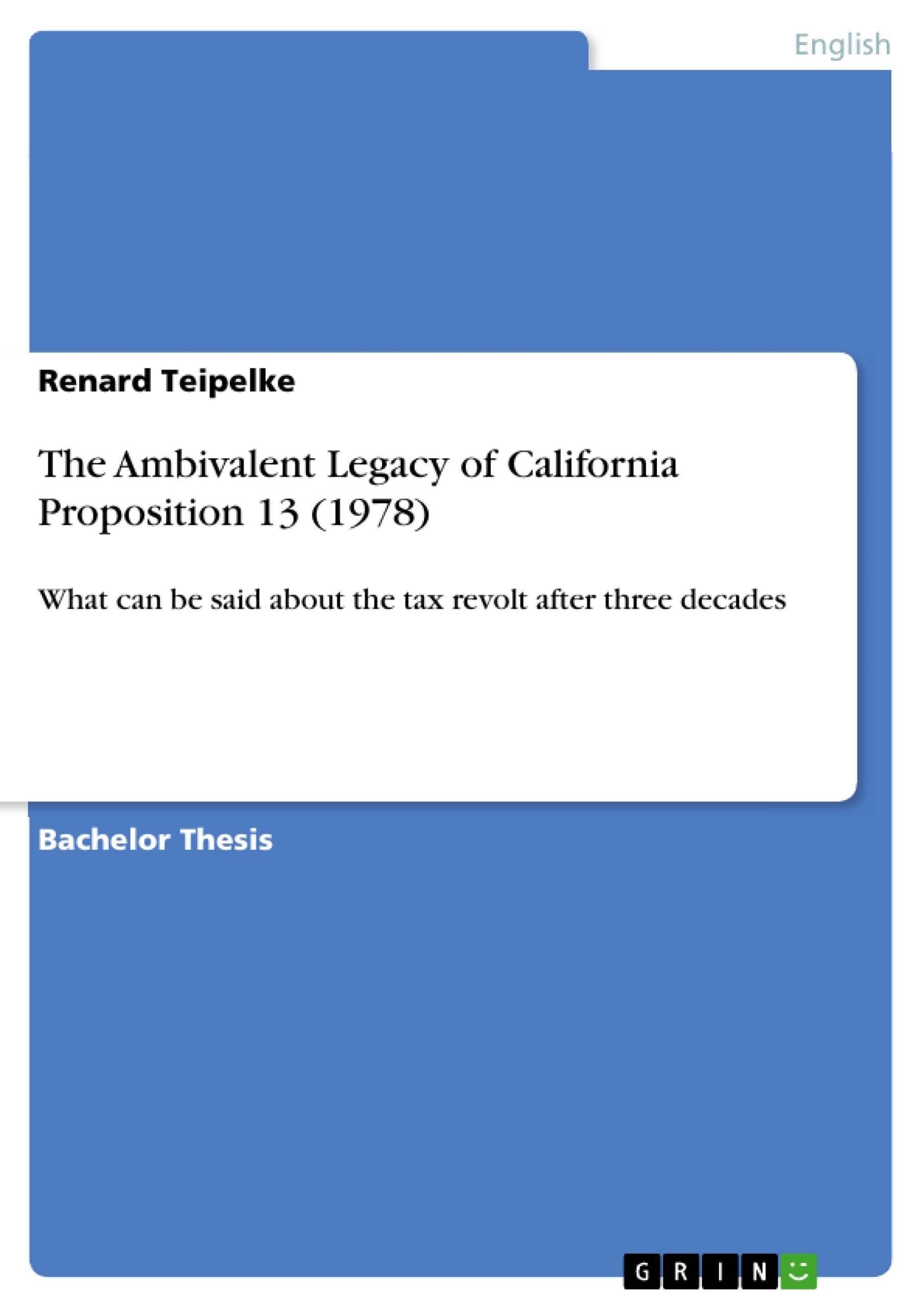The objective of this work is to bring together findings from different research fields and organize them in a way that helps to detect the ambivalent legacy of Proposition 13 three decades after its ballot success. Since this initiative is such a buzzword in politics, the media, and academia, I will show why Proposition 13 has been both the darling of California citizens and the scapegoat for everything that has presumably gone wrong in the state. With this objective, it is not sufficient to solely focus on the changed fiscal structure of local governments or the role of Howard Jarvis as ‘the small people’s hero.’ Therefore, I will extract Proposition 13’s main aspects that have formed its lasting legacy. I will do so by presenting my findings in three parts: The first part will focus on the initiative’s 1978 ballot success and causes as well as its sponsors and opponents. I will show that the voters’ motivation to overwhelmingly approve Proposition 13 was not a sign of sharply reversed attitudes toward government and public services, but was rather based on two essential aspects: voters requested an immediate, substantial, and permanent property tax relief and wanted to send a strong message to their inactive and unresponsive government through the power of the initiative process. The second part will analyze the proposition’s (unanticipated) impacts on the state and local governments and California citizens – with regard to fiscal, socioeconomic, and political impacts. Among other aspects, I will explain why the hopes of the initiative’s sponsors for shrinkage of big government were dashed while the alarming prophesies of Proposition 13’s opponents were not fulfilled to their anticipated magnitude. With respect to the political impact of the initiative, I will show that the unanticipated shift in power relations between the state and local governments has been one of the most important effects of the proposition. Finally, the third part will turn to the changing debate about Proposition 13’s role in the nationwide tax revolt of the 1970s and 1980s as well as in California over the past three decades. I will proceed to analyze the double-edged legacy of Proposition 13 as both the darling of California citizens and the scapegoat for the state’s problems. I will underscore the relation between direct democracy and Proposition 13 and identify possible positive results and repercussions of the initiative process as it is used in California.
Table of Contents
1. Introduction
1.1 Proposition 13 in 1978
1.2 State of Scholarship
1.3 Methodology
2. Proposition 13’s Ballot Success
2.1 Causes of Proposition 13
2.1.1 The Pre-Proposition 13 Property Tax System
2.1.2 The Escalating Property Tax
2.1.3 State Government Inaction and Unresponsiveness
2.2 Proposition 13’s Sponsors and Opponents
2.2.1 Proposition 13’s Sponsors
2.2.2 Proposition 13’s Opponents
2.3 Voters
2.3.1 A Diversely Mixed Coalition
2.3.2 Requesting a Property Tax Relief
2.3.3 Fighting Big Government
2.3.4 Sending a Message to an Inactive and Unresponsive Government
2.4 Conclusion
3. Proposition 13’s Impacts
3.1 Fiscal Impacts of Proposition 13
3.1.1 Fiscal Impacts on the State Level
3.1.2 The State Bailout
3.1.3 Fiscal Impacts on the Local Level
3.1.4 Long-Term Development
3.2 Socioeconomic Impacts of Proposition 13
3.2.1 Socioeconomic Impacts on Public Services
3.2.2 Businesses in the New Property Tax System
3.2.3 The New Property Tax System and Horizontal Inequities
3.3 Political Impacts of Proposition 13
3.3.1 Political Impacts on Local Governments
3.3.2 Political Impacts on the State Government
3.4 Conclusion
4. Proposition 13’s Role
4.1 Tax Revolt in the Nation
4.2 Proposition 13 as California Citizens’ Darling
4.3 Proposition 13 as the Scapegoat in California Politics
4.3.1 Proposition 13 and Local Finances
4.3.2 Proposition 13 and Public School Education
4.4 Proposition 13 Showing the Path for Direct Democracy in California
4.4.1 Characteristics of the Initiative Process in California
4.4.2 Outcomes of Direct Democracy in California
4.5 Conclusion
5. Conclusion: The Ambivalent Legacy of Proposition
Appendix 1
TIME Magazine Cover: “Tax Revolt!” (19 June 1978)
Appendix 2
State and Local Per Capita Tax Burden in Fiscal 1976-1977
Appendix 3
Election Results for Proposition 13 by County
Appendix 4
Inflation-Adjusted Per Capita Fiscal Data for California
Appendix 5
Major Post-Proposition 13 State and Voter-Approved Actions
Appendix 6
California City General Revenues, by Source, as a Percentage of Total General Revenues, 1972-2002 (in percent)
Appendix 7
Hypothetical Example of Horizontal Inequities in an Acquisition Tax System
Appendix 8
Tax Limitations Spread Rapidly after 1978
Appendix 9
California City General Expenditures by Function, as a Percentage of Total General Expenditures, 1972-2002 (in percent)
Bibliography



